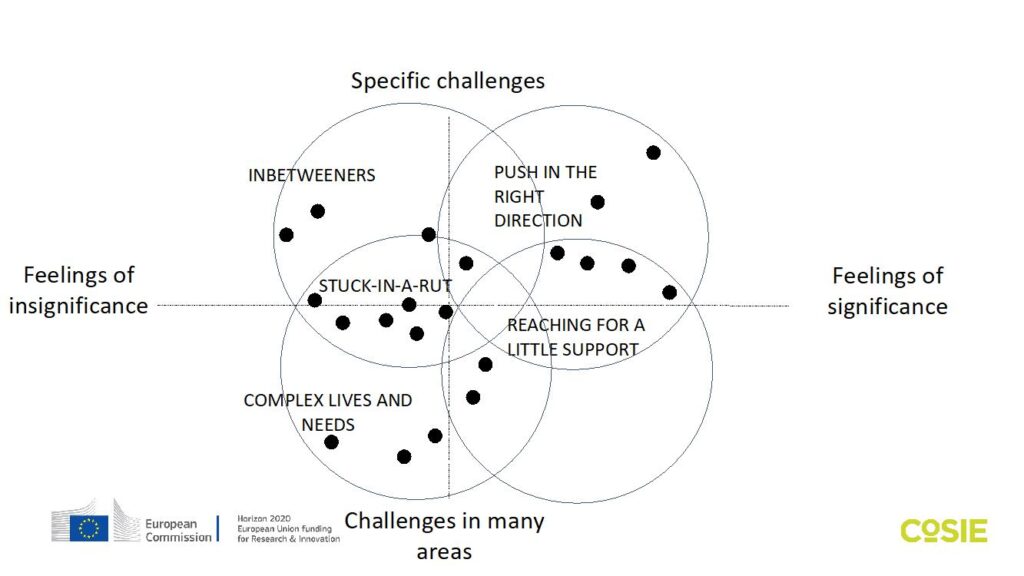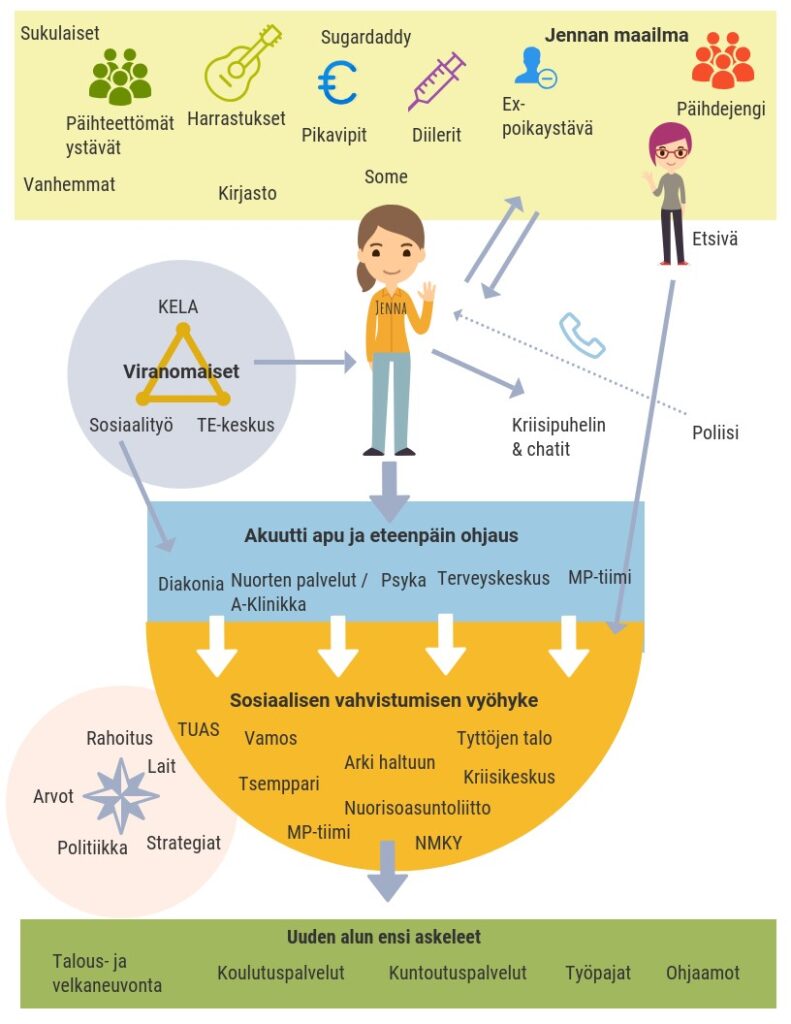Methods and tools
Some work to identify the targeted group needs was initiated by a student master thesis work (‘Using Service Design: User Research methods clarifying residents’ needs in municipality; by Eloluoto, 2018) based on design-thinking in public services. Eloluoto examined the needs of young people aged 20–29 years in Turku, using professional and target group interviews, probes and a workshop as methods. She found that with young people having multiple challenges, the most important needs are support to one’s identity and a helping hand to create meaningful relationships. Moreover, assistance with formulating the future and structuring everyday life is important. For example, if there are problems with mental health, the recognition and right treatment is crucial.
A further needs analysis was undertaken by TUAS students in roles as Community Reporters and as a part of the co-design approach.
- Students gathered stories from the target group (NEET youths)
- People’s Voice Media (UK) instructed students as Community reporters
- Community Reporters in Turku were students from social services work programme
- 22 videos with voices we collected, where young people tell about their lives and challenges in life
The analysis of the collected youngster voices resulted in a new schematic typology with four types (archetypes) of need groups among marginalised youth, see Figure 1. The needs analysis used two dimensions – type of needs and sense of significance (sense of meaning).
Figure: Needs analysis

A typical example of a youth need type with specific challenges and a feeling of insignificance:
A lack of direction in life causes anxiety. It is easy to escape this anxiety to the virtual world. Many have suffered from bullying at school and have low self-esteem. Loneliness is commonplace.
All of the themes that emerged from needs analysis and the profiles were discussed with a project Steering group. It was agreed that these and the typical problems related to them sounded familiar. The young people emphasised the meaning of long-lasting and intensive help, e.g. some kind of a support person. A professional was not considered as such, as the support person should be available all times and be on the same level as them. They emphasised plenty of problems within the service system: specifically its inflexibleness and the lack of sufficient mental health services, both of which have also arisen from discussions with the professionals. In addition, the steering group brought forth the pressures to succeed, which are nowadays high.
Next, dialogues were held with the officials from the city of Turku, and with national and regional-level youth NGO (YMCA), to discuss the form and the possible participants to the kick-off and Hackathons. YMCA has organised several Hackathons to young people in Finland, together with several other youth NGOs. Other youth organisations and vocational schools were also contacted via email or by phone and asked if the organisation have access to youths, who might be interested to participate.
The Kick off meeting or Living lab
To create common understanding and enhance the inclusiveness and commitment to our work, the pilot arranged a kick-off meeting, a Living Lab to professionals, together with the city of Turku. They included e.g. service structure specialist, inclusion coordinator, welfare coordinator and open data specialist; grass-root workers from different kind of services, such as social sector, youth sector, aforementioned ‘Ohjaamo’; employment office; experts from several organisations working with marginalised youth, such as YMCA; youth worker from local parish; curator from secondary school; representative from the social security institution in Finland.
In this kick-off meeting, the pilot team aimed to create common understanding: how professionals from different fields act and interact with each other, in relation to young people, and how the situation should be, using four of the profiles as a starting point.
The kick-off meeting deepened our understanding about different kinds of problems marginalised youth are facing, and served as a foundation to Hackathons. Besides the participants were able to network with pilot partners. This likely made the participants more committed to Hackathons.
To support co-creative development of service improvements an interaction map has been drawn in conversations with stakeholders and youth for each of the 4 youth profiles trying to identify what roles and how are involved in assisting youth.The goal was to have an informed general view of the profile’s connections and situation. The focus was not on describing organizational barriers but primarily the roles, functions and opportunities to make a difference.
Co-creation hackathons
As next step, 2 co-creation hackathons were organized with stakeholders and the youth to be able to discuss the profiles and solutions for the profile’s challenges. These hackathons were attended by city officials and frontline workers, working with youths in different sectors. There were also representatives from several NGOs, employment office, ‘Ohjaamo’ service, vocational school, social insurance institution of Finland, open data specialist from the city and county-level official. We started the Hackathons by telling about our pilot activities so far and presented the four profiles. Then the participants started to develop possible solutions in small groups, in a facilitated process. Each group consisted of both employers and youths, and the project members from Association of Municipalities and Regional Authorities and TUAS researchers facilitated the activities. We wanted the work to be based on the profiles created earlier, so that the youths did not feel the pressure to open up about their personal situations. This approach was successful. Most of the youth said they could recognise themselves in the profiles. We were told several times at the start of the pilot that it would be difficult to attract young people to join co-creation activities. This was proven wrong. The young participants were open, insightful and excited, regardless of their difficult backgrounds.

The use of open data, Social media and Digital technologies
- Contacting young people through social media in community reporter work package.
- TUAS student did an experimenting workshop, in which they investigated, from where in social media to find marginalized youth.
- Posts from social media were gathered and analyzed and used as a source of knowledge in the design sprint.
- Open data about the health and welfare of Turku’s youth and state of welfare management in the city in the city of Turku were used as a source of knowledge in design sprint.
The role of open data: Increasing municipal transparency.